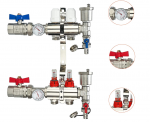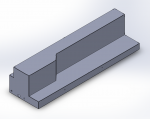Waiting for lunch to cook, and looking ahead to a few items that need resolved prior to winter. On of these is freeze control for the gray water tank and lines. Another (farther down the road) is heating the engine and possibly fuel tank/lines.
Since I will need to relocated my hydronic heater due to the battery box install, I am considering a redesign.
-Isolate hydronic heating loop from engine, due to increased plumbing
-Install plate heat exchanger for preheating engine
-Plumb heating coil for gray (and eventually custom fuel tank)
-Plumb heating lines for drain hoses
-Design control unit which can run the pumps and heater to: Heat water tank from engine, heat engine from hydronic loop, and perform anti-freeze operation.
Doing some googling to see what options I have, I came across this floor heating manifold set. It looks like each circuit has a thermostatic valve on the return side. So I can adjust the temperature of each loop as needed. That would reduce heat loss to the tanks in warm weather. Its pretty big though. I am not sure what kind of flow resistance it would create either.









 IMG_20200729_125624525
IMG_20200729_125624525 IMG_20200728_084531260
IMG_20200728_084531260 IMG_20200728_090237857
IMG_20200728_090237857 IMG_20200729_081821921
IMG_20200729_081821921



